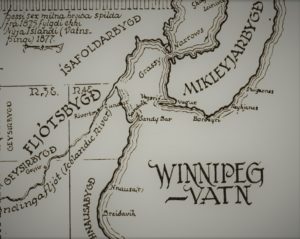ÍSAFOLDARBYGGÐ (ÍSAFOLD Settlement):
The Ísafold Settlement is north of the Fljóts Settlement, mostly on the west bank of Lake Winnipeg, north of where it was called Hay Point or Heytangi. What attracted the settlers to the area were grassy meadows and thick forest where land rose high enough so that flooding in the lake did not reach there. The main detraction, however, were swamps and marshes which made all land transport almost impossible. It is said that Pétur Bjarnason had the idea for the name when he took over the settlement in 1892, and it is such that when floods occurred in the autumn, meadows froze, thin ice covered there in the first frosts. Pétur received a permit for a post office in his house and it was named Ísafold P.O. The area north of Icelandic River (Íslendingafljót) stood outside the land that the Canadian government granted to Icelanders as a special area for New Iceland in 1875. When Sigtryggur Jónasson and the exploration committee came to the estuaries of the Icelandic River in July that year, it is certain that this area attracted their attention because of the grassy meadows. Sigtryggur Jónasson and the land survey committee came to the estuaries of Íslendingafljót in July of that year, it is certain that this area attracted their attention because of the grassy meadows, wherever they looked no less than the grassland up by the river. Despite this, no one sought refuge in this area during the bad years 1875-1880, it was not until 1882 that Jón Bjarnason, a settler in Mikley, settled there that year when his wife, Halldóra Guðmundsdóttir gave birth to his son Berg on 1 November. Jón did not manage to get a good foothold in the area, he is a registered resident of Sandy Bar in Fljóts in the beginning of 1885. Various things caused people to come to the area from the middle of the decade, mainly due to the large number of migrations to New Iceland, both from Winnipeg and also Iceland when large groups went from there west across the ocean in the years 1886-1888. The daily life of the settlers in the Ísafold Settlement was shaped primarily by local conditions, on the one hand the meadows and forests and on the other hand Lake Winnipeg. Farming was characterized by cattle breeding, people had cattle, dairy cows, sheep and chickens. Almost no experiment was done with grain cultivation, the land simply did support such. What was cleared was used by farmers as vegetable gardens.

The map shows Ísafoldarbyggð north of Fljótsbyggð. The settlement is separated from Mikleyjarbyggð where it is called Grassy Narrows. There, the island has now been connected to the mainland by landfill.
Settlers were entitled to 160 acres and most of them let that suffice, there were few farmers that tried to expand. Here people could produce for themselves and theirs, but what was left over, farmers tried to use to obtain other necessities, equipment of various kinds and tools, fishing nets, etc. Fishing in Lake Winnipeg was a great boon, as in those years it was full of fish. As an example of this, there are many stories of prosperous fishermen who often caught fish on every hook, but it was common for each line to have 50 hooks! Most people caught whitefish, pickerel or pike. Fish was salted, dried or smoked in the summer but frozen in the winter. Those who returned home relied on a fishing boat in the summer and fishing through ice in the winter, but the fishing industry was gaining a foothold from various ports by the lake. Most settlers owned small sailboats for both transport and fishing.
No settler became rich in the Ísafold Settlement to the same extent as their various countrymen on the plains of Southern Manitoba and N. Dakota. Most, however, did well compared to what was considered normal in New Iceland at that time. At home, solid log cabins were made from selected logs glued together with lime mortar. They were heated with the best available firewood from nearby forests and although cash was often scarce, there was always plenty of food in the homes, luxuries that some had not experienced before, even at home in Iceland. Wells were dug in many places and there was enough crystal clear water in almost every home and although the forest made it difficult for people to travel in many places, it made up for it with many advantages. There were often game animals to be had and a variety of berries grew everywhere.
All kinds of difficulties awaited the settlers in the new settlement, especially those who had just arrived in the West. It was a challenge to get a foothold in the wilderness, the isolation and distance from the markets sometimes unbearable. The Ísafold Settlement was no exception, perhaps more difficult than many other settlements because the marshes and swamps made all the zooming, transport to the market as well as social life many times more difficult. Markets in New Iceland, so to speak, were generally unfavorable at best, simply because everyone was producing the same thing. Selkirk and Winnipeg were widely marketed, and therefore each household often lacked various necessities, necessities that could not be produced at home.
English version by Thor group.
